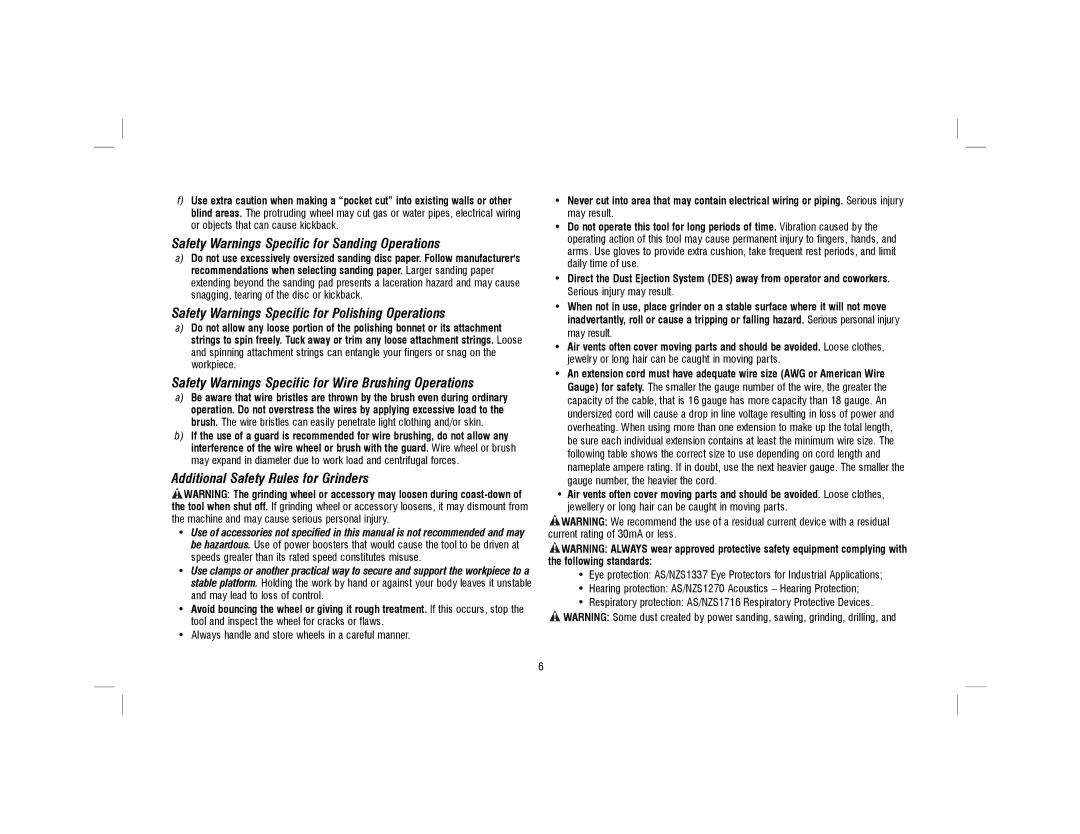
f) Use extra caution when making a “pocket cut” into existing walls or other blind areas. The protruding wheel may cut gas or water pipes, electrical wiring or objects that can cause kickback.
Safety Warnings Specific for Sanding Operations
a)Do not use excessively oversized sanding disc paper. Follow manufacturer's recommendations when selecting sanding paper. Larger sanding paper extending beyond the sanding pad presents a laceration hazard and may cause snagging, tearing of the disc or kickback.
Safety Warnings Specific for Polishing Operations
a)Do not allow any loose portion of the polishing bonnet or its attachment strings to spin freely. Tuck away or trim any loose attachment strings. Loose and spinning attachment strings can entangle your fingers or snag on the workpiece.
Safety Warnings Specific for Wire Brushing Operations
a)Be aware that wire bristles are thrown by the brush even during ordinary operation. Do not overstress the wires by applying excessive load to the brush. The wire bristles can easily penetrate light clothing and/or skin.
b)If the use of a guard is recommended for wire brushing, do not allow any interference of the wire wheel or brush with the guard. Wire wheel or brush may expand in diameter due to work load and centrifugal forces.
Additional Safety Rules for Grinders
![]() WARNING: The grinding wheel or accessory may loosen during
WARNING: The grinding wheel or accessory may loosen during
•Use of accessories not specified in this manual is not recommended and may be hazardous. Use of power boosters that would cause the tool to be driven at speeds greater than its rated speed constitutes misuse.
•Use clamps or another practical way to secure and support the workpiece to a stable platform. Holding the work by hand or against your body leaves it unstable and may lead to loss of control.
•Avoid bouncing the wheel or giving it rough treatment. If this occurs, stop the tool and inspect the wheel for cracks or flaws.
•Always handle and store wheels in a careful manner.
•Never cut into area that may contain electrical wiring or piping. Serious injury may result.
•Do not operate this tool for long periods of time. Vibration caused by the operating action of this tool may cause permanent injury to fingers, hands, and arms. Use gloves to provide extra cushion, take frequent rest periods, and limit daily time of use.
•Direct the Dust Ejection System (DES) away from operator and coworkers. Serious injury may result.
•When not in use, place grinder on a stable surface where it will not move inadvertantly, roll or cause a tripping or falling hazard. Serious personal injury may result.
•Air vents often cover moving parts and should be avoided. Loose clothes, jewelry or long hair can be caught in moving parts.
•An extension cord must have adequate wire size (AWG or American Wire Gauge) for safety. The smaller the gauge number of the wire, the greater the capacity of the cable, that is 16 gauge has more capacity than 18 gauge. An undersized cord will cause a drop in line voltage resulting in loss of power and overheating. When using more than one extension to make up the total length, be sure each individual extension contains at least the minimum wire size. The following table shows the correct size to use depending on cord length and nameplate ampere rating. If in doubt, use the next heavier gauge. The smaller the gauge number, the heavier the cord.
•Air vents often cover moving parts and should be avoided. Loose clothes, jewellery or long hair can be caught in moving parts.
![]() WARNING: We recommend the use of a residual current device with a residual current rating of 30mA or less.
WARNING: We recommend the use of a residual current device with a residual current rating of 30mA or less.
![]() WARNING: ALWAYS wear approved protective safety equipment complying with the following standards:
WARNING: ALWAYS wear approved protective safety equipment complying with the following standards:
•Eye protection: AS/NZS1337 Eye Protectors for Industrial Applications;
•Hearing protection: AS/NZS1270 Acoustics – Hearing Protection;
•Respiratory protection: AS/NZS1716 Respiratory Protective Devices.
![]() WARNING: Some dust created by power sanding, sawing, grinding, drilling, and
WARNING: Some dust created by power sanding, sawing, grinding, drilling, and
6
